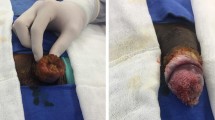Abstract
Giant condyloma acuminata, first described by Buschke and Löwenstein in 1925 as a penile lesion, is extremely rare in the anorectal region. The cauliflower-like tumor behaves clinically in a malignant fashion, although it shows no histomorphological criteria of malignancy. Up to the time of writing only 33 cases of anorectal origin, 42% with malignant transformation, have been published. The authors report 2 more cases of squamous-cell carcinoma in giant anorectal condylomata acuminata. Buschke-Löwenstein tumor is an intermediate entity between “ordinary” condyloma acuminata and squamous-cell carcinoma. Benign condyloma acuminata is caused by human papillomavirus 6 or 11. Carcinogenic cofactors promote the transition to giant, locally destructive condyloma acuminata and subsequent malignant transformation. Cure can only be achieved by early and radical excision. Formation of multiple fistulas and destruction of the sphincter may necessitate abdomino-perineal resection. Adjuvant radiation therapy should only be considered to render a tumor operable, as radiation may act as a cocarcinogenic effect and lead to a less differentiated and more aggressive cancer. The small number of cases reported and the variety of treatment regimens applied, however, do not allow the formulation of definitive therapeutic guidelines.
Zusammenfassung
Das Riesenkondylom in anorektaler Lokalisation ist eine extreme Rarität. Obwohl der blumenkohlförmige Tumor klinisch ein malignes Wachstum zeigt, erfüllt er nicht die histomorphologischen Kriterien der Malignität. In der Literatur sind bis heute 33 Fälle eines Riesenanorektalkondyloms beschrieben worden, davon 42% mit maligner Transformation in ein Schuppenzellkarzinom. Zwei weitere Fälle eines invasiven Schuppenzellkarzinoms auf dem Boden eines Riesenzellkondyloms werden berichtet. Der Buschke-Löenstein-Tumor ist ein Zwischenstadium des “einfachen” Kondyloms und des Schuppenzellkarzinoms. Condylomata acuminata werden durch die humanen Papillomavirus-Typen 6 und 11 verursacht. Karzinogene Kofaktoren bewirken den Übergang in das Riesenkondylom mit lokal destruierendem Wachstum und folgender maligner Transformation. Nur die rechtzeitige, lokale, radikale Exzision im Gesunden verspricht therapeutischen Erfolg. Multiple Fisteln und die Zerstörung des Sphinkterapparates können die abdominoperineale Rektumamputation erforderlich machen. Eine Bestrahlung sollte nur erfolgen, um Operabilität herzustellen, da sie einen kokarzinogen Effekt auf den Tumor aufweist und eine Entdifferenzierung in ein aggressiv wachsendes Karzinom auslöst.
Similar content being viewed by others
References
Boshardt M, Zur Hausen H (1986) Human papillomavirus in Buschke-Löwenstein tumors: physical state of the DNA and identification of a tandem duplication in the noncoding region of a human papillomavirus 6 subtype. J Virol 58:963–966
Buschke A, Löwenstein L (1925) Über Carcinomdönliche Condylomata Acuminata des Penis. Klin Wochenschr 4:1726–1728
Butler TW, Gefter J, Kleto D, Shuck EH, Ruffner BW (1987) Squamous-cell carcinoma of the anus in condyloma acuminatum — successful treatment with preoperative chemotherapy and radiation. Dis Colon Rect 30:293–295
Creasman C, Haas PA, Fox TA, Balazs M (1989) Malignant transformation of anorectal giant condyloma acuminatum (Buschke-Löenstein tumor). Dis Colon Rect 32:481–487
Dörner A, Winkler R, Mitschke H (1987) Der Buschke-Löwenstein-Tumor — ein malignes Condylom. Chirurg 58:842–844
Elliot MS, Werner ID, Immelman EJ, Harrison AC (1979) Giant condyloma (Buschke-Löwenstein tumor) of the anorectum. Dis Colon Rect 22:497–500
Feindt P, Schilder G, Kreißler-Haag D, Feifel G (1993) Monströser Buschke-Löwenstein-Tumor (Condylomata acuminatum gigantea) mit Übergang in ein invasiv wachsendes Plattenepithelcarcinom. Chirurg 64:499–502
Gingrass PJ, Bubrick MP, Hitchcock CR, Strom RL (1977) Anorectal verrucous squamous carcinoma: report of two cases. Dis Colon Rect 21:120–122
Gissmann L, De Villiers E-M, Zur Hausen H (1982) Analysis of human genital warts (condylomata acuminata) and other genital tumor for human papillomavirus type 6 DNA. Int J Cancer 29:143–146
Jenkins HML, Riley VC (1980) A review of outpatient management of female genital warts. Br J Clin Pract 34:273
Knoblich R, Failing JF (1967) Giant condyloma acuminatum (Buschke-Löwenstein tumor) of the rectum. Am J Clin Pathol 48:389–395
Lee SH, McGregor DH, Kuziez MN (1981) Malignant transformation of perianal condyloma acuminatum: a case report with review of the literature. Dis Colon Rect 24:462–467
Lock MR, Katz DR, Samoorian S, Parks AG (1976) Giant condyloma of the rectum: report of a case. Dis Colon Rect 20: 154–157
Lowell DM, LiVolsi VA, Ludwig ME (1983) Genital condyloma virus infection following pelvic radiation therapy: report of seven cases. Int J Gynecol Pathol 2:294–302
Lynch PJ (1985) Condylomata acuminata (anogenital warts) Clin Obstet Gynecol 28:142–151
Nash G, Allen W, Nash S (1982) Atypical lesions of the anal mucosa in homosexual men. JAMA 256:873–876
Powell LC (1972) Condyloma acuminatum. Clin Obstet Gynecol 15:948
Rübben A, Beaudenon S, Favre M, Schmitz W, Spelten B, Grussendorf-Conen E-I (1992) Rearrangements of the upstream regulatory region of human papillomavirus type 6 can be found in both Buschke-Löwenstein tumours and in condylomata acuminata. J Virol 73:3147–3153
Wells M, Griffiths S, Lewis F, Bird CC (1987) Demonstration of human papillomavirus types in paraffin-processed tissue from human anogenital lesions by in-situ DNA hybridisation. J Pathol (Lond) 152:77–82
Author information
Authors and Affiliations
Rights and permissions
About this article
Cite this article
Bertram, P., Treutner, K.H., Rübben, A. et al. Invasive squamous-cell carcinoma in giant anorectal condyloma (Buschke-Löwenstein tumor). Langenbecks Arch Chir 380, 115–118 (1995). https://doi.org/10.1007/BF00186418
Received:
Issue Date:
DOI: https://doi.org/10.1007/BF00186418




